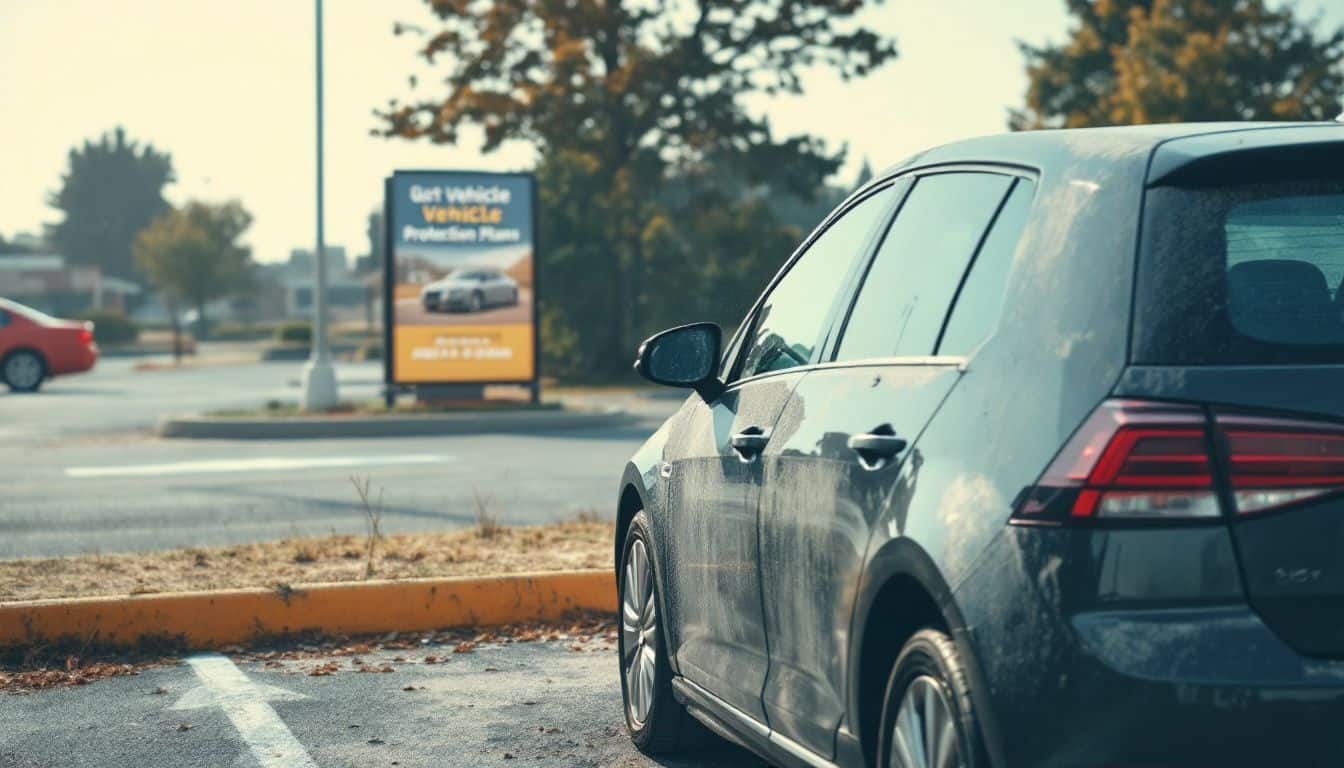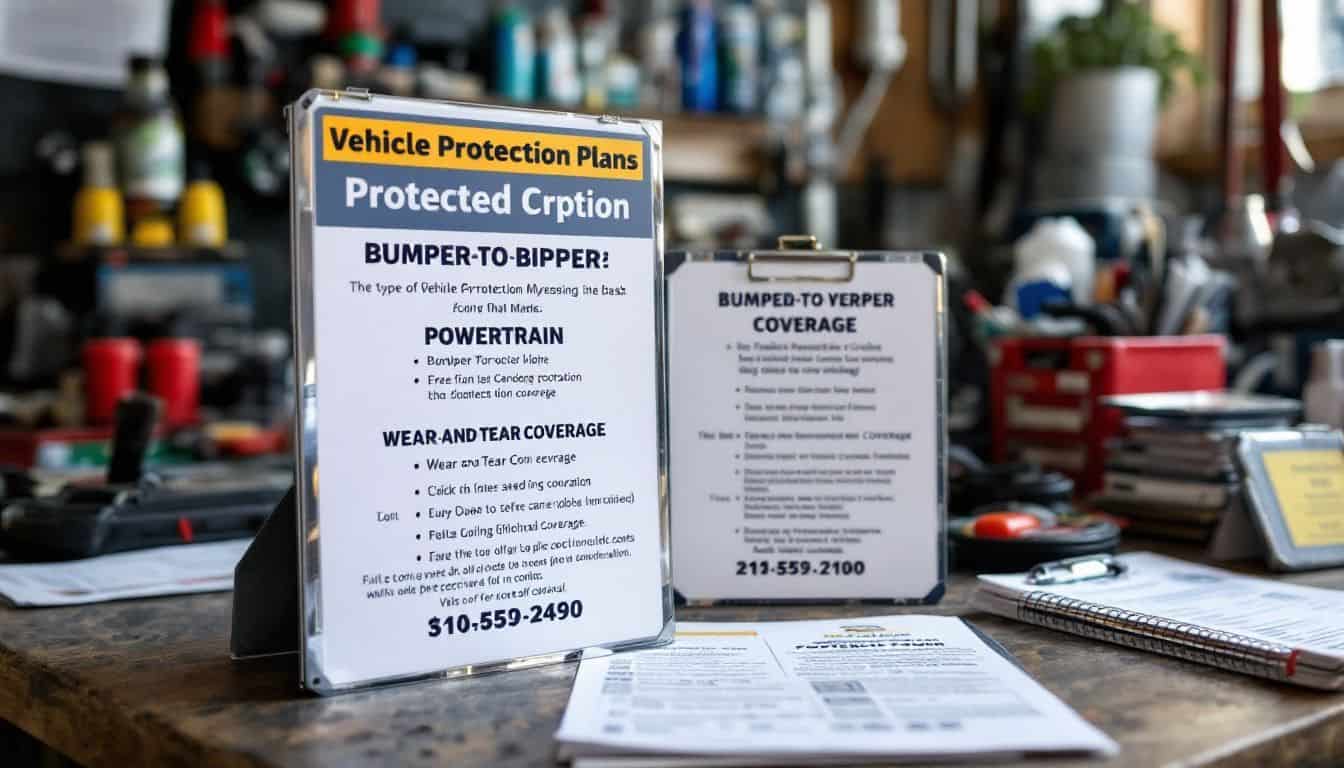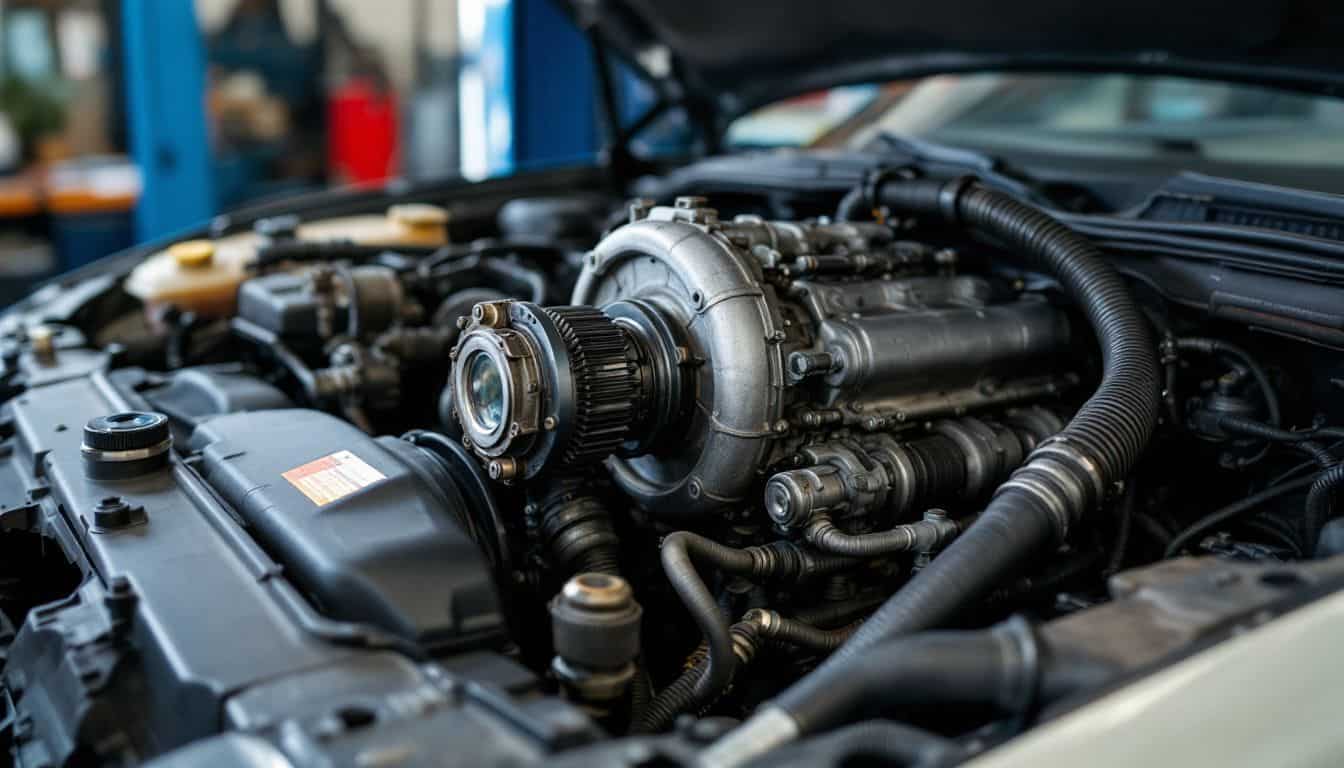Car trouble strikes at the worst times. A vehicle protection plan shields you from unexpected repair costs. This article unveils 5 key features of these plans. You’ll learn what is a vehicle protection plan and how it can save you money.
Key Takeaways
Vehicle protection plans cover repair costs after factory warranties end, with average plans costing $848 per year.
Key features include major repair coverage, 24/7 roadside help, and rental car options up to $35 per day for 10 days.
Plans come in different types like powertrain (5-10 years coverage), bumper-to-bumper, and wear-and-tear options.
Benefits include saving on repair costs, peace of mind, and boosting resale value.
Plans don’t cover routine maintenance, accident damage, or effects of vehicle modifications.
Table of Contents
Exploring Vehicle Protection Plans

Now that we’ve covered the basics, let’s explore vehicle protection plans in more detail. These plans offer peace of mind for car owners.
They cover repair costs after factory warranties end. Most plans have five coverage levels: Platinum, Gold, Silver, Powertrain, and Engine.
Protection plans are like a safety net for your vehicle’s future.
The average plan costs $848 per year. This price can save you thousands on major repairs. Plans often have a 30-day or 1,000-mile waiting period before you can make claims. This rule helps prevent fraud and ensures fair use for all customers.
Essential Features of Vehicle Protection Plans

Vehicle protection plans offer key perks. They cover major repairs and provide roadside help.
Major Repair Coverage

Major repair coverage is the heart of vehicle protection plans. It pays for big fixes on key parts like engines and transmissions. These repairs often cost thousands of dollars. A good plan covers most major systems in your car.
This includes the electrical system, air conditioning, and steering.
Plans vary in what they cover. Some only protect the engine and transmission. Others cover almost everything from bumper to bumper. The best plans even pay for high-tech parts in newer cars.
Next, let’s look at how roadside help fits into these plans.
Roadside Help

Moving from major repair coverage, let’s talk about roadside help. This key feature of vehicle protection plans offers peace of mind on the road.
Roadside help includes 24/7 emergency assistance. You get help with gas, towing, flat tires, dead batteries, and lockouts. Most plans cover up to $100 for towing and locksmith services.
This support is there for you day or night, all year round. It’s like having a mechanic on call, ready to rescue you from common car troubles.
Roadside assistance is your lifeline when car troubles strike.
Rental Car Options

Vehicle protection plans often cover rental car costs. You can get up to $35 per day for 10 days if your car needs repairs. This helps you stay mobile while your vehicle is in the shop.
Plans may also pay for rentals if your car breaks down far from home. This feature saves you money and stress during unexpected repairs.
Rental coverage gives you freedom to keep your daily routine. You won’t have to rely on others for rides or pay out of pocket for a temporary car. It’s a key benefit that makes protection plans more valuable.
Check the details of any plan to see exactly what rental options it offers.
Diverse Types of Vehicle Protection Plans

Vehicle protection plans come in different types… Learn more about powertrain, bumper-to-bumper, and wear-and-tear options.
Powertrain Warranty Insights
 Powertrain warranties cover key parts of your car’s engine and drivetrain. These include the engine, transmission, and drive axles. Most car makers offer this coverage for 5 years or 60,000 miles.
Powertrain warranties cover key parts of your car’s engine and drivetrain. These include the engine, transmission, and drive axles. Most car makers offer this coverage for 5 years or 60,000 miles.
Some, like Hyundai, go up to 10 years or 100,000 miles. This warranty helps protect your manly car from costly repairs.
A powertrain warranty is like a safety net for your car’s heart and muscles.
These warranties don’t cover everything. They skip parts that wear out fast, like brake pads and clutches. They also don’t fix damage from crashes or misuse. But they do guard against defects in major parts.
This can save you thousands on big repairs. It’s smart to check what’s covered before you buy a car.
Comprehensive Bumper-to-Bumper Coverage

Bumper-to-bumper coverage guards most car parts. It’s the most complete plan for your ride. This type covers almost everything from engine to electronics. Most new cars come with this warranty.
It lasts about 3 to 5 years.
Third-party bumper-to-bumper plans cost about $977 per year. They protect against costly breakdowns. But they don’t cover wear items or routine upkeep. Things like oil changes and brake pads are your job.
Always check what’s in and out of the plan before you buy.
Excess Wear and Tear Options
Moving beyond basic coverage, excess wear and tear options offer extra protection. These plans shield you from costly end-of-lease charges. They cover dents, torn seats, and other damages up to $5,000 total.
Toyota offers this plan for new and certified used cars. It’s available at lease start for terms up to 60 months. The plan caps payouts at $1,000 per event and $200 for missing parts.
You can transfer it only if you reassign the original lease contract.
Advantages of Vehicle Protection Plans

Vehicle protection plans offer big perks. They cut repair costs and give you peace of mind on the road.
Save on Repair Costs
Vehicle protection plans slash repair bills. These plans cover costly fixes, saving you big bucks. The average plan costs $977 per year, but it can save thousands on major repairs.
For example, a new engine could cost $5,000 or more without coverage. With a plan, you’d only pay a small deductible. This applies to all cars, from daily drivers to supercars.
Plans act as a budget tool, spreading repair costs over time. Instead of one huge bill, you pay smaller amounts monthly. This helps manage cash flow and reduces financial stress. A five-year contract costs about $4,000 total.
That’s peace of mind for half a decade of potential car troubles. Plus, you avoid dipping into savings or using credit cards for surprise repairs.
Enhance Peace of Mind
Saving on repair costs leads to more peace of mind. Vehicle protection plans offer 24/7 roadside help. This service gives drivers confidence in emergencies. No more worries about breakdowns or being stranded.
You can drive with ease, knowing help is just a call away.
Plans also cover specific car parts. This helps budget for future repairs. Knowing what’s covered lets you plan ahead. You won’t face surprise bills for major fixes. This security allows you to enjoy your drives without stress.
A vehicle protection plan is like a safety net for your car and your wallet.
Boost Vehicle Resale Value
Vehicle protection plans boost resale value. They make cars more appealing to buyers. Buyers feel safer knowing repair costs are covered. This added security can increase a car’s worth in the used market.
Comprehensive coverage options often lead to higher resale prices. Buyers see value in cars with existing protection plans.
Resale value goes up with transferable plans. These plans move to new owners easily. Cars with active plans sell faster. They often fetch better prices too. Buyers like the idea of continued coverage after purchase.
This peace of mind translates to higher offers for protected vehicles.
Typical Exclusions in Vehicle Protection Plans

Vehicle Protection Plans don’t cover everything. They often skip routine upkeep and crash damage.
Excluding Routine Maintenance
Vehicle protection plans don’t cover routine maintenance. This means oil changes, tire rotations, and brake pad replacements are your responsibility. The plan focuses on major repairs, not regular upkeep.
Skipping these tasks can void your warranty. Keep records of all maintenance to protect your coverage.
Regular care keeps your car running smoothly. It prevents bigger issues down the road. Most plans require you to follow the maker’s maintenance schedule. This includes fluid checks, filter changes, and tune-ups.
Stick to these rules to keep your protection valid and your car in top shape.
Accident-Related Damage
Routine maintenance differs from accident damage. Vehicle protection plans often exclude crash-related repairs. Most plans don’t cover dents, scratches, or broken parts from collisions.
This applies to both minor fender benders and major wrecks. Insurance usually handles these issues instead.
Natural disasters also fall outside plan coverage. Floods, hurricanes, and other extreme events can cause severe vehicle damage. Protection plans typically won’t pay for repairs in these cases.
It’s crucial to understand these limits before buying a plan. Knowing what’s covered helps avoid surprises later.
Effects of Vehicle Modifications
Moving from accident damage to car changes, let’s talk about how mods affect your ride. Car mods can hike up your insurance costs. Why? They make your car riskier to insure. If you don’t tell your broker about these changes, you might lose coverage.
Some mods, like turbo kits, can make your car more tempting to thieves. They can also lead to more aggressive driving. Plus, mods often void your car’s factory warranty. So think twice before you soup up your ride.
Selecting the Ideal Vehicle Protection Plan

Picking the right plan means looking at what you need, what it costs, and how easy it is to make claims… Want to know more about choosing the best protection for your car?
Evaluate Coverage Requirements
Check your car’s needs before picking a plan. Look at your car’s age, make, and how you use it. This helps you get the right coverage. A newer car might need more protection than an older one.
High-mileage cars often need extra care for wear and tear.
Think about what parts break most in your car model. Some cars have weak spots that need extra coverage. Ask about these when shopping for plans. Compare different plans to see which fits your car best.
This saves money and gives peace of mind.
Analyze Plan Costs
After looking at what you need, it’s time to check costs. Plan prices vary a lot. Some cost $977 per year. Others run up to $4,000 for five years. Look at your budget and car’s value.
Compare quotes from different companies. Ask about deductibles too. These can range from $0 to $200 per repair. Lower deductibles mean higher plan costs. Higher ones cut your upfront costs but raise out-of-pocket expenses.
Pick a plan that fits your wallet and gives good coverage.
Review the Claims Process
Check the claims process before you buy a plan. Look for easy filing steps and a wide repair network. Good plans let you file claims online or by phone. They also work with many repair shops.
This makes it simple to get your car fixed fast. Some plans even pay the shop directly, so you don’t have to wait for reimbursement.
A smooth claims process saves time and stress. Pick a plan that explains clearly what’s covered and what’s not. This helps avoid surprises when you need repairs. Next, let’s look at the costs and deductibles of vehicle protection plans.
Understanding Costs and Deductibles of Vehicle Protection Plans

Vehicle protection plans come with costs and deductibles. These vary based on your car’s make, model, and age.
Exploring Typical Cost Ranges
Vehicle protection plans vary in price. The average cost is $848 per year. A five-year contract can run about $4,000 total. Prices depend on your car’s make, model, and age. For example, a 2017 Ford Explorer with 45,000 miles might cost $3,181.94 with Endurance or $3,652.02 with CARCHEX.
These plans often cost less than paying for major repairs out of pocket. Next, let’s look at how deductibles work in these plans.
Deductible Mechanisms
Vehicle protection plans often come with deductibles. These range from $0 to $200. You pay this amount when you make a claim. The deductible applies to both parts and labor costs. Plans offer different options to fit your budget.
Some plans tie deductibles to coverage levels. A Platinum plan might have a lower deductible than a Silver plan.
Choosing a higher deductible can lower your overall plan cost. But you’ll pay more out-of-pocket for each repair. Lower deductibles mean higher upfront costs but less expense per claim.
Pick a deductible that matches your financial comfort level and expected repair needs.
People Also Ask
What’s a vehicle protection plan?
It’s like an extended warranty for your car… covers repairs after the factory warranty ends. Helps with costs if your ride breaks down.
How’s it different from car insurance?
Car insurance handles accidents, theft. A protection plan? It’s for mechanical issues. Think engine trouble, transmission woes… stuff that wears out over time.
What are some key features to look for?
Look for rental car help, roadside assistance… maybe even trip interruption coverage. Good plans cover major parts – engine, transmission, electrical system.
Can I get one for any car?
Most plans work for newer cars, but some cover older ones too. Electric cars, hybrids, even some trucks… there’s usually a plan out there. Check the mileage limits.
Who offers these plans?
Dealerships, third-party providers… even some car makers. Do your homework – check Better Business Bureau ratings, read customer reviews. Shop around.
Is it worth the cost?
Depends on your car, how long you’ll keep it… your budget too. Weigh the plan cost against potential repair bills. For some, peace of mind is worth it.
References
- https://www.automoblog.com/reviews/auto-warranty/vehicle-protection-plan/
- https://www.autonation.com/protection-plans/autonation-vehicle-protection-plan
- https://www.autonationtoyotacerritos.com/financing/autonation-protection-plans.htm
- https://www.autonationhondadulles.com/financing/autonation-vehicle-protection-plans.htm
- https://www.kbb.com/car-advice/powertrain-warranty/ (2024-08-23)
- https://www.marketwatch.com/guides/car-warranty/bumper-to-bumper-warranty/
- https://www.toyotafinancial.com/us/en/vehicle_protection_plan/excess_wear_use_protection.html
- https://www.usatoday.com/money/homefront/auto-warranty/auto-warranty-exclusions/ (2024-09-30)
- https://www.usatoday.com/money/homefront/auto-warranty/vehicle-protection-plans/
- https://knightins.net/blog/vehicle-modification-impact-on-insurance
- https://techbullion.com/motoassure-how-to-choose-the-best-vehicle-protection-plan-for-your-needs/
- https://www.driveway.com/learn/financing/what-is-a-vehicle-protection-plan

